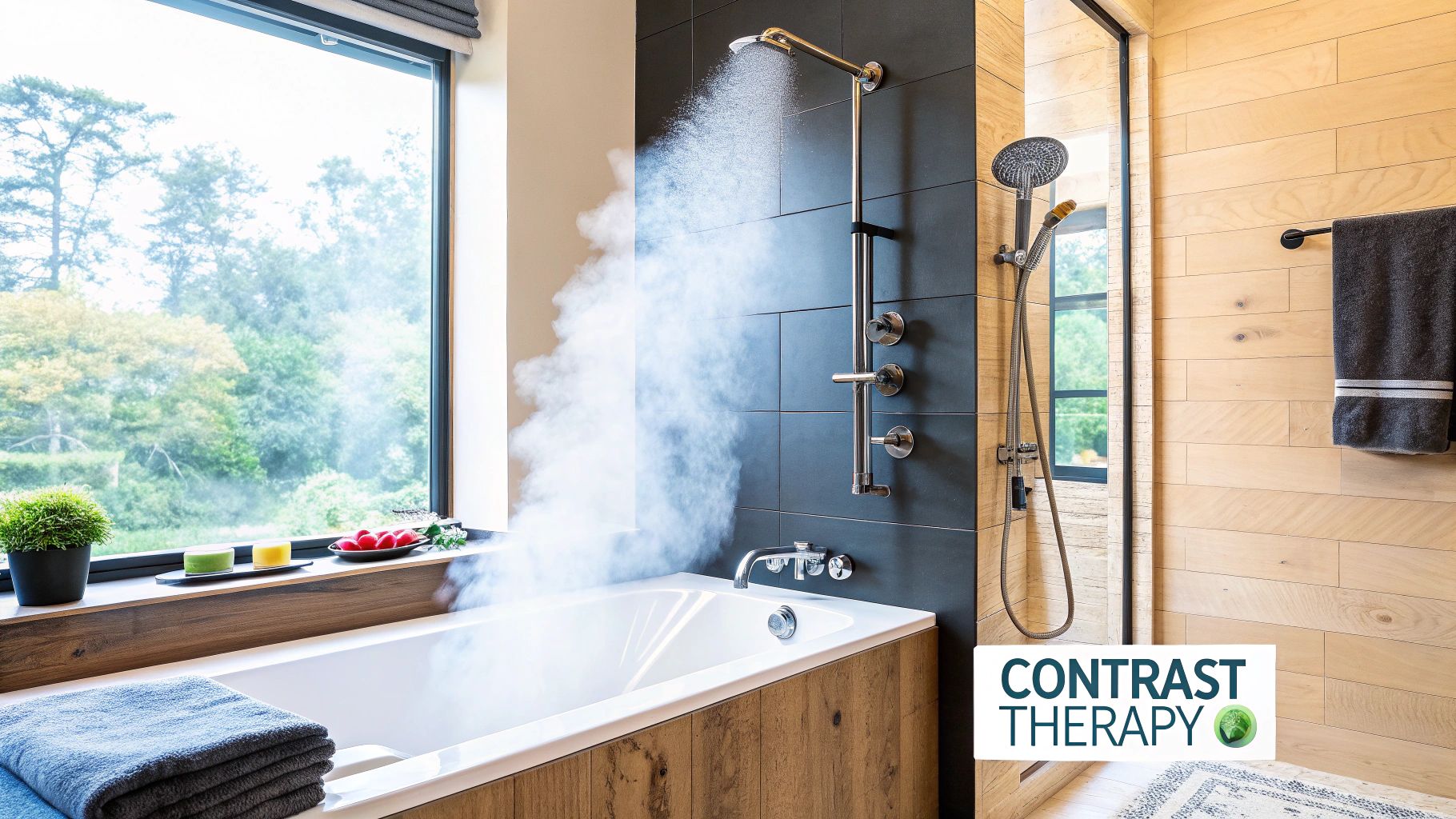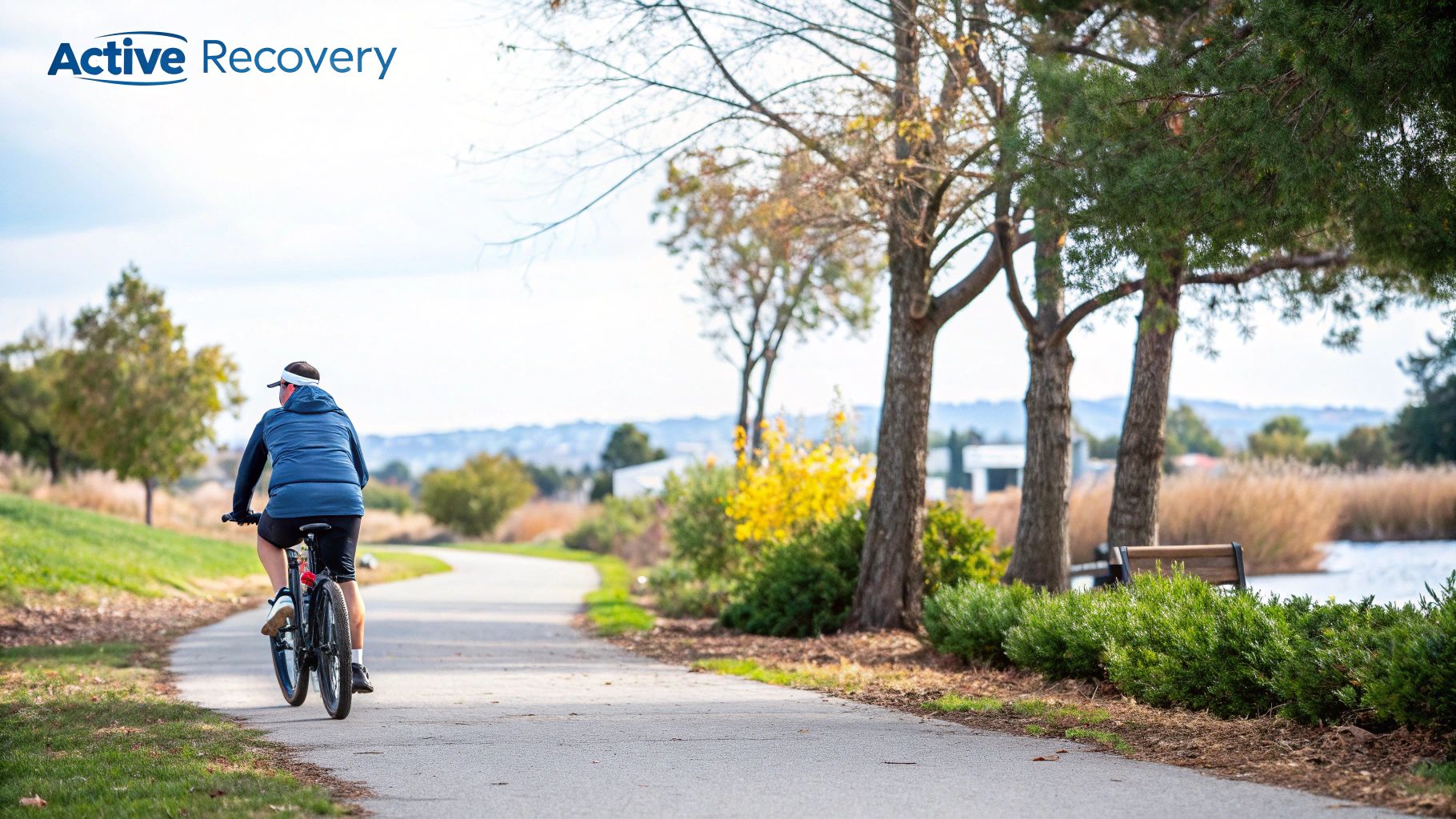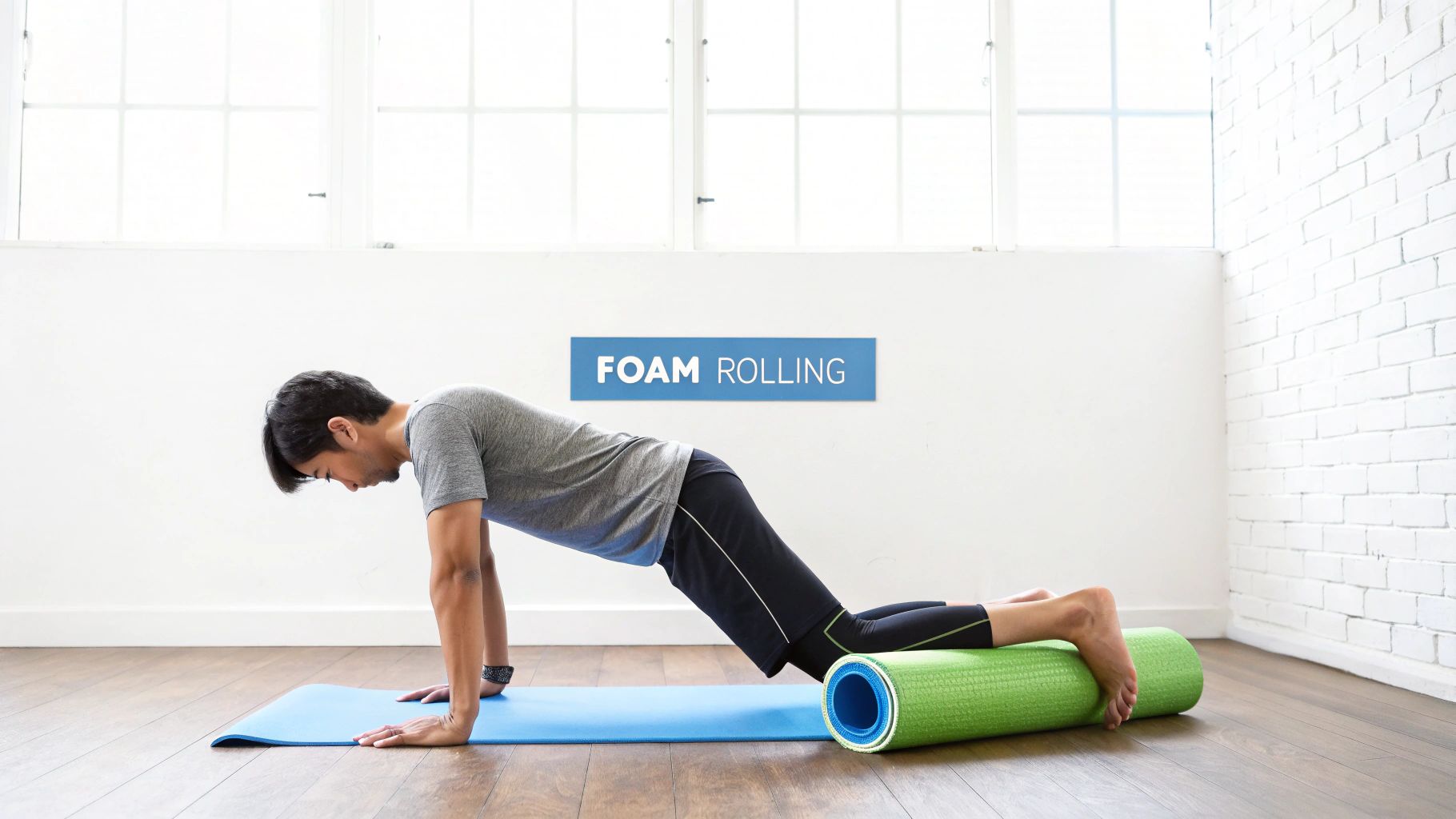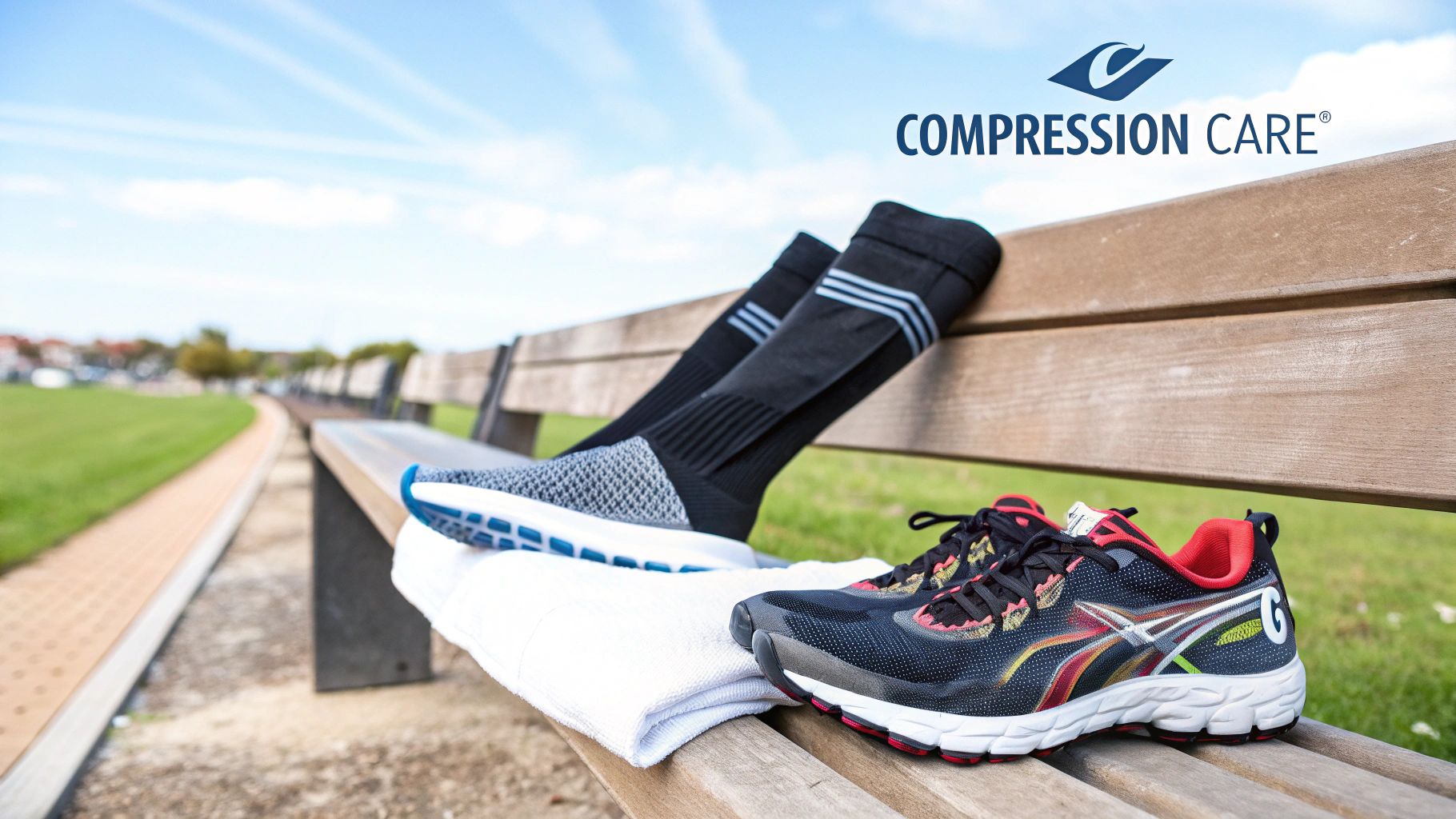That satisfying ache after a tough training session is a badge of honor, but when Delayed Onset Muscle Soreness (DOMS) transitions from a gentle reminder into a debilitating pain, it can derail your progress and hinder performance. The key isn't to stop training hard; it's to recover smarter. For those dedicated to their fitness, especially within a plant-based or health-conscious lifestyle, optimizing recovery is just as crucial as the workout itself. Managing soreness effectively means less downtime and more consistent training, which is fundamental to achieving long-term strength and endurance goals.
This guide moves beyond the generic "stretch and rest" advice. We will explore seven potent, science-backed strategies that elite athletes and recovery experts use to effectively reduce muscle soreness after workout. From leveraging specific temperature contrasts with hydrotherapy to optimizing your body's natural repair cycles through targeted nutrition and strategic rest, these methods are designed for immediate implementation. You will learn practical techniques like self-myofascial release and active recovery to actively manage discomfort. Prepare to transform your post-exercise routine from a passive waiting game into a strategic advantage, helping you bounce back faster and consistently hit your fitness goals.
1. Master Contrast Hydrotherapy (Hot/Cold Shock)
Contrast hydrotherapy is a powerful recovery technique that involves alternating between hot and cold water immersion. This "shock" to the system causes your blood vessels to rapidly constrict (vasoconstriction) in the cold and expand (vasodilation) in the heat. This process creates a dynamic pumping action that helps flush metabolic waste, like lactate, from your muscles and significantly reduces inflammation, a primary driver of delayed onset muscle soreness (DOMS).

While once the domain of elite athletes in high-tech facilities, this method is now widely accessible. It's the same principle used by NBA teams with custom hydrotherapy pools and Olympic swimmers who follow intense training with ice baths and hot showers. You can easily replicate this at home to effectively reduce muscle soreness after a workout.
How to Implement Contrast Hydrotherapy
The key to success is consistency and proper protocol. The goal is to create a significant temperature differential to trigger the physiological response.
- The Classic Protocol: A common and effective ratio is 3 minutes of heat followed by 1 minute of cold. Repeat this cycle 3 to 5 times.
- The Final Step: Always end your session on cold. This final phase of vasoconstriction helps lock in the anti-inflammatory benefits, leaving your muscles primed for recovery.
- Optimal Timing: For the best results in combating soreness, perform contrast therapy within the first one to two hours following your workout.
Expert Tip: Don't get discouraged if the cold feels intense at first. Start with shorter cold exposures, perhaps just 30 seconds, and gradually work your way up to a full minute or more as your body adapts.
Hot tubs are an excellent tool for the heat portion of this therapy. The deep, penetrating warmth helps relax tense muscles before the invigorating cold plunge. For a deeper dive into how hot tubs can contribute to your overall well-being, consider exploring their benefits in a comprehensive wood-fired hot tub wellness guide. This powerful combination of hot and cold is a game-changer for accelerating recovery and minimizing post-exercise pain.
2. Active Recovery and Light Exercise
While it might seem counterintuitive, gentle movement is often more effective than complete rest for alleviating muscle stiffness. Active recovery involves performing low-intensity exercise following a strenuous workout. This approach boosts circulation to your tired muscles, helping to deliver oxygen-rich blood and clear out metabolic byproducts like lactate that contribute to soreness. It's about keeping the body moving, not stopping it completely.

This method has long been a staple for professional athletes who need to recover quickly. You'll see Tour de France cyclists going for easy "recovery rides" on their off days, and NFL players participating in light swimming sessions between games. The goal is to facilitate recovery, not to add more training stress, which is a key way to reduce muscle soreness after a workout.
How to Implement Active Recovery
The principle is simple: move gently and listen to your body. The intensity should be low enough that it feels restorative, not taxing.
- Keep it Low-Impact: Focus on activities that are easy on your joints. Think walking, swimming, light cycling, or a gentle yoga flow.
- Monitor Your Effort: A good rule of thumb is to keep your heart rate below 40% of your maximum. You should be able to hold a full conversation easily.
- Optimal Duration: Aim for a session lasting 20 to 30 minutes. This is enough time to increase blood flow without causing additional fatigue.
- Timing is Key: Active recovery can be performed immediately after a tough workout as a "cool-down" or on the following day to combat the onset of DOMS.
Expert Tip: Choose an activity you genuinely enjoy. If you dread your recovery session, it becomes another stressor. It could be a walk in the park, a casual bike ride with family, or even some light stretching while watching TV.
By incorporating these gentle movements, you actively support your body's natural healing processes, preventing stiffness and helping you bounce back faster. This proactive approach is a cornerstone of smart training and long-term athletic performance. For more insights on optimizing your routine, explore some additional exercise blogs on cantein.com.
3. Foam Rolling and Self-Myofascial Release
Self-myofascial release (SMR), commonly known as foam rolling, is a self-massage technique that applies pressure to your muscles and the surrounding connective tissue, or fascia. This targeted pressure helps to break up adhesions and knots, release muscle tension, and improve blood flow to the targeted areas. By doing so, it can significantly alleviate the tightness and discomfort associated with DOMS.

This practice has become a staple in modern fitness, championed by physical therapists and strength coaches like Mike Boyle. You'll see it integrated into CrossFit gym warm-ups and cool-downs, and even specialized yoga studios now offer classes dedicated to it. Its popularity is a testament to its effectiveness in helping athletes and everyday gym-goers reduce muscle soreness after a workout and improve overall mobility.
How to Implement Foam Rolling
Proper technique is crucial for getting the most benefit from foam rolling without causing further irritation. It’s about slow, controlled pressure, not rapid, painful rolling.
- Go Slow: Move the roller very slowly across the muscle belly, about one inch per second. When you find a particularly tender spot (a "trigger point"), pause and hold direct pressure on it for 30-60 seconds, or until you feel the tension start to release.
- Avoid Joints and Bones: Never roll directly over your joints, such as the back of your knee, or bony prominences like your spine or hip bone. This can cause inflammation and injury.
- Breathe: Remember to breathe deeply and relax into the pressure. Tensing up is counterproductive to releasing muscle tightness.
Expert Tip: If you're new to foam rolling, start with a softer, lower-density roller. As your tissues adapt and your tolerance for the pressure increases, you can progress to firmer rollers or even lacrosse balls for more targeted, intense pressure on specific knots.
Combining foam rolling with static stretching can create a powerful synergistic effect. Roll a muscle group first to increase blood flow and release tension, then follow up with a gentle stretch to improve the muscle's length and flexibility.
4. Proper Nutrition and Hydration
Proper nutrition and hydration are the foundational pillars of effective muscle recovery. What you consume after exercising provides the essential raw materials your body needs to repair damaged muscle fibers, replenish depleted energy stores (glycogen), and fight inflammation. Neglecting this crucial step is like asking a construction crew to build a house without bricks or mortar; your body simply won't have the resources it needs to effectively reduce muscle soreness after a workout.

This strategy is universally adopted by elite athletes who work closely with sports nutritionists to dial in their post-workout protocols. It’s why marathon runners are often seen sipping tart cherry juice to combat inflammation and why cyclists have long sworn by chocolate milk as a near-perfect recovery drink, offering an ideal ratio of carbohydrates to protein. This approach isn't just for pros; it's a fundamental principle for anyone looking to optimize their recovery and performance.
How to Implement Proper Nutrition and Hydration
Timing and composition are everything when it comes to your post-workout meal and fluid intake. The goal is to act quickly to kickstart the repair process.
- The Anabolic Window: Aim to consume a meal or snack rich in protein and carbohydrates within 30 to 60 minutes after your workout. This period is when your muscles are most receptive to nutrient uptake.
- Focus on Anti-Inflammatory Foods: Incorporate foods known for their anti-inflammatory properties, such as berries, leafy greens, turmeric, and ginger, to naturally manage soreness.
- Hydrate Consistently: Don't wait until you're thirsty. Sip water throughout the day, before, during, and after your workout. Monitoring your urine color (aiming for a pale yellow) is a simple way to gauge your hydration status.
Expert Tip: A robust immune system, supported by good gut health, is also vital for your body's recovery and ability to handle the stress of intense workouts. You can explore how probiotics for immunity can further bolster your defenses.
Properly fueling your body post-exercise is a non-negotiable for minimizing pain and maximizing gains. For practical and delicious ways to refuel, you can find inspiration in these 7 post-workout meal ideas to fuel your recovery. By making smart nutritional choices, you give your body the tools it needs to bounce back stronger.
5. Prioritize Quality Sleep and Rest
While active recovery methods are beneficial, the most powerful and non-negotiable tool for muscle repair is deep, restorative sleep. It is during the deep stages of sleep that your body releases the majority of its human growth hormone (HGH), a key anabolic hormone responsible for repairing damaged muscle tissue and stimulating growth. Quality sleep also helps regulate inflammatory responses and restores your central nervous system, which is crucial for managing fatigue and preventing overtraining.
The importance of sleep is championed by elite athletes and performance experts alike. NBA star LeBron James is famous for targeting up to 12 hours of sleep per night for recovery, while performance-focused companies like Oura and Whoop have built entire platforms around tracking and optimizing sleep for athletes. This underscores a fundamental truth: without adequate sleep, all other recovery efforts are compromised. Consistently prioritizing rest is a direct way to reduce muscle soreness after a workout.
How to Optimize Your Sleep for Recovery
Improving sleep quality involves creating a consistent routine and an environment conducive to rest. The goal is to maximize the time your body spends in the deep, restorative stages of the sleep cycle.
- Create a Sanctuary: Your bedroom should be cool (around 65°F or 18°C), completely dark, and quiet. Use blackout curtains, eye masks, and a white noise machine or earplugs to eliminate disruptions.
- Establish a Wind-Down Routine: Avoid stimulating activities and blue light from screens for at least 60 minutes before bed. Instead, try reading a physical book, gentle stretching, or meditating.
- Maintain a Consistent Schedule: Go to bed and wake up at the same time every day, even on weekends. This reinforces your body's natural sleep-wake cycle, or circadian rhythm, making it easier to fall asleep and wake up feeling refreshed.
Expert Tip: Proper nutrition can significantly impact sleep. A high-protein snack before bed can provide your body with the amino acids needed for overnight muscle repair. Pairing this with your nightly routine can enhance the recovery process, as detailed in this guide to top protein supplements for muscle recovery on cantein.com.
By treating sleep with the same seriousness as your training, you provide your body with the essential foundation it needs to repair, rebuild, and come back stronger, with significantly less soreness.
6. Embrace Compression Therapy
Compression therapy leverages targeted external pressure to enhance circulation and accelerate recovery. This method uses either specialized garments or pneumatic devices to apply graduated pressure to your limbs, which helps your body's circulatory and lymphatic systems work more efficiently. This enhanced fluid movement speeds up the removal of metabolic waste products, like exercise-induced creatine kinase, and reduces the swelling and inflammation that contribute to delayed onset muscle soreness (DOMS).
This isn't just about wearing tight clothing; it’s a science-backed technique. You see it in action with elite marathon runners finishing a race and immediately putting on compression socks, or professional basketball players like LeBron James using pneumatic compression boots (like NormaTec) to recover between games. By applying precise pressure, these tools provide a passive way to reduce muscle soreness after a workout and get you back to training faster.
How to Implement Compression Therapy
Effective compression relies on the right fit, timing, and pressure. Improper application can be ineffective or even counterproductive, so attention to detail is key.
- Choose the Right Tool: You can use static compression garments (socks, sleeves, or tights) or dynamic pneumatic compression devices (boots or sleeves that inflate and deflate). Garments are great for prolonged, gentle use, while devices offer a more intense, massage-like session.
- Prioritize Proper Fit: For garments, ensure they provide graduated compression, meaning they are tighter at the extremity (like the ankle) and looser closer to the body. This gradient is crucial for promoting fluid return. Ill-fitting gear won't deliver the intended benefits.
- Optimal Timing and Duration: The ideal window for a compression session is within a few hours post-workout. Aim for a 20 to 30-minute session with a pneumatic device. For garments, they can be worn for several hours following intense exercise.
Expert Tip: For maximum effectiveness, combine compression therapy with elevation. Lie on your back and prop your legs up against a wall while using compression boots or wearing socks. This uses gravity to further assist in draining fluid and waste products from your legs.
Start with lower pressure settings on pneumatic devices and gradually increase as your comfort allows. This controlled, targeted pressure helps mitigate the micro-trauma from exercise, making it an indispensable tool for anyone serious about managing muscle soreness and optimizing their recovery protocol.
7. Massage and Manual Therapy
Massage and manual therapy are time-tested techniques that directly address muscle tension, improve circulation, and accelerate the healing process. By applying targeted pressure, these methods help break up adhesions and scar tissue, flush out metabolic byproducts, and reduce inflammation. This hands-on approach not only alleviates physical discomfort but also provides significant psychological benefits by promoting relaxation and reducing stress.
The use of massage is ubiquitous in elite sports, with professional teams and Olympic athletes relying on dedicated massage therapists to stay in peak condition. Today, tools like percussion massagers from brands like Theragun and Hyperice have brought professional-grade therapy into homes, making it easier than ever to reduce muscle soreness after a workout. These techniques work by increasing blood flow to the targeted muscles, delivering vital oxygen and nutrients while clearing out waste.
How to Implement Massage and Manual Therapy
Effective massage therapy, whether professional or self-administered, requires proper timing and technique to maximize its benefits for muscle recovery.
- Optimal Timing: Schedule a professional massage or use a self-massage tool within 24 to 48 hours following an intense workout. This window is ideal for addressing the peak of delayed onset muscle soreness (DOMS).
- Communicate Clearly: When working with a therapist, be specific about sore spots and your preferred pressure level. This ensures the treatment is both effective and comfortable.
- Stay Hydrated: Drink plenty of water before and after your session. Hydration aids the lymphatic system in flushing out the metabolic waste that massage releases from your muscles.
Expert Tip: For daily maintenance between professional sessions, learn basic self-massage techniques using a foam roller, lacrosse ball, or massage gun. Focusing for just 5-10 minutes on tight areas like your quads, hamstrings, or upper back can make a profound difference in your recovery and flexibility.
Regularly incorporating massage is a powerful strategy for not just treating soreness but preventing it. The cumulative benefits include improved tissue health, greater range of motion, and a better mind-muscle connection. This makes it an indispensable tool for anyone serious about their fitness and recovery.
7 Methods to Reduce Muscle Soreness Comparison
| Recovery Method | Implementation Complexity 🔄 | Resource Requirements ⚡ | Expected Outcomes 📊 | Ideal Use Cases 💡 | Key Advantages ⭐ |
|---|---|---|---|---|---|
| Contrast Hydrotherapy (Hot/Cold) | Medium (access to hot & cold water) | Moderate (ice baths, tubs, showers) | Reduces inflammation & DOMS, improves circulation | Post-workout recovery, athletes with access to facilities | Immediate pain relief, circulation boost |
| Active Recovery and Light Exercise | Low (simple low-intensity movement) | Low (minimal equipment needed) | Reduces stiffness, maintains fitness | Rest days, maintaining flexibility and blood flow | Enjoyable, maintains cardiovascular health |
| Foam Rolling and Self-Myofascial Release | Medium (technique dependent) | Low (foam rollers, balls) | Reduces muscle tension, improves flexibility | Pre/post workout muscle maintenance | Portable, cost-effective, immediate relief |
| Proper Nutrition and Hydration | Medium (planning and timing needed) | Variable (food, supplements) | Accelerates repair, reduces inflammation | Daily recovery, muscle repair, energy replenishment | Supports overall health, sustainable approach |
| Quality Sleep and Rest | Low (requires lifestyle discipline) | Minimal (sleep environment setup) | Enhances hormone release, muscle synthesis | Daily recovery, injury prevention, mental & physical rest | Most cost-effective, holistic recovery |
| Compression Therapy | Medium (proper sizing, use knowledge) | Moderate to high (garments/devices) | Reduces swelling & soreness, improves circulation | Post-exercise, injury recovery, swelling reduction | Passive use possible, various forms available |
| Massage and Manual Therapy | High (professional skill required) | High (therapist fees, scheduling) | Relieves tension, improves flexibility and relaxation | Targeted muscle treatment, psychological relaxation | Personalized, immediate tension relief |
Build Your Ultimate Recovery Protocol
Navigating the landscape of post-workout recovery can feel as intense as the workout itself. We've explored seven powerful, science-backed strategies designed to help you reduce muscle soreness after workout sessions, transforming your approach from passive endurance to active management. The familiar ache of Delayed Onset Muscle Soreness (DOMS) is a badge of honor, signaling that you've challenged your body and initiated the process of growth. However, chronic, unmanaged soreness can derail your progress, sap your motivation, and increase your risk of injury. The true secret to sustained fitness achievement lies not just in the intensity of your training, but in the intelligence of your recovery.
The key takeaway is that recovery is not a one-size-fits-all prescription. It's a dynamic and personal system you build over time. By experimenting with the methods discussed, you can craft a protocol that is uniquely yours. Think of these strategies as individual tools in your recovery toolkit. Some days, the sharp contrast of hydrotherapy might be exactly what your body needs. On others, a gentle active recovery session or a focused session with a foam roller will be more beneficial.
Creating Your Personalized Recovery System
The most effective approach is to combine several of these techniques. Your body is a complex system, and a multi-faceted recovery plan addresses its needs from different angles. Consider this framework for building your own protocol:
- Immediate Post-Workout: This is the critical window. Focus on a proper cool-down, immediate rehydration, and a nutrient-rich meal or shake featuring high-quality protein to kickstart the muscle repair process.
- Later in the Day: This is the perfect time for techniques like foam rolling to release muscle tension, or contrast hydrotherapy to boost circulation and flush out metabolic waste.
- The Following Day (Peak Soreness): When DOMS is at its most intense, gentle movement is your ally. Engage in light active recovery like walking or cycling, and consider compression wear to support aching muscles and reduce swelling.
- Ongoing Habits: Consistent, high-quality sleep and a dialed-in nutrition plan are the non-negotiable foundations of your recovery. These are the habits that work silently in the background, ensuring your body has the resources it needs to rebuild stronger every single night.
Listen, Adapt, and Conquer
Ultimately, the most crucial skill is learning to listen to your body. Pay attention to its signals. How do you feel after trying a cold plunge versus a hot bath? Does a 15-minute foam rolling session make a noticeable difference the next day? This biofeedback is your most valuable data. By actively testing and refining your approach, you move from simply enduring soreness to strategically conquering it. Mastering how to reduce muscle soreness after workout sessions is not about eliminating discomfort entirely; it's about optimizing your body's natural healing processes. This proactive stance empowers you to return to your next workout feeling refreshed, resilient, and ready to perform at your peak.
Ready to supercharge your nutritional recovery? Give your muscles the clean, plant-based fuel they need with Cantein. Our high-quality vegan protein is specifically designed to support muscle repair and reduce recovery time, making it the perfect addition to your post-workout routine. Visit Cantein to find your perfect protein partner.

